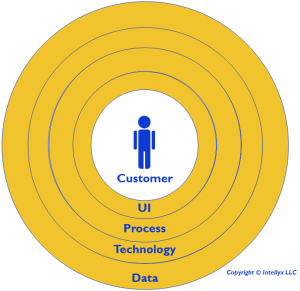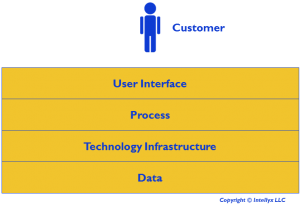Digital transformation impacts all corners of the business, and perhaps the most important corner to us here at Intellyx is the dark cul-de-sac where the enterprise architects huddle.
Because of their unique capability to maintain and communicate the big picture of enterprise transformation, EAs can be critical to the success of a digital initiative – but only if they slough off the paperwork-laden, gatekeeper-centric thinking of the EA of days past.
Instead, EAs must empower their organization to achieve success with digital efforts through the proper use of digital architecture – where ‘digital architecture’ is shorthand for enterprise architecture that’s laser focused on driving digital transformation.
What, therefore, does this digital architecture look like? How is it different than other, more traditional approaches to EA? And given all the complexities of digital transformation, where do you start with digital architecture?
At the center, of course.
Finding the Center of your Digital Architecture
Just like Dorothy in Munchkinland, it’s important to start at the beginning. Where, then, is the center of our EA in today’s digital world, what we’re calling digital architecture?
Many people believe data are at the center of the digital effort. Data are certainly important to digital to be sure, and every technology effort boils down to ones and zeroes in the end. Data, however, aren’t the right place to start.
Cloud architecture puts technology infrastructure at the center. SaaS depends upon PaaS which rests on IaaS, and IaaS abstracts the technology infrastructure. So for the cloud architect, it’s turtles all the way down, until you get to bare metal.
However, even though the cloud – or more broadly, cloud-centric architectural thinking – is a critical component of digital architecture, infrastructure isn’t the right place to start, either.
What about applications? There’s plenty of buzz about the ‘application economy’ these days, after all. There’s also no arguing with the fact that the importance of mobile apps in particular is a major factor in most digital transformation efforts. But no, apps aren’t at the center of digital architecture.
If not apps, then what about APIs? The ‘application economy’ is really the ‘API economy,’ according to some pundits, anyway. I like to think of APIs as the glue that holds the digital world together. Digital might fall apart without APIs, but clearly glue itself can’t be at the center of digital architecture, right?
Give up? Here’s a clue. Intellyx defines ‘digital’ as customer preferences and behavior drive enterprise technology decisions.
That’s right. The customer must be at the center of your digital architecture.
What Does It Mean to Have Customer-Centered Architecture?
In order to put some teeth into the notion of customer-centered architecture, we must navigate between two dangerous misperceptions.
First, we must avoid ‘customer-washing’ our enterprise architecture. We’re not simply highlighting or emphasizing the role customers have always played in traditional approaches to EA. Instead, we’re reworking the whole kit and caboodle to put customers at the center, which requires a top to bottom rethink of how we approach our architecture.
The second danger is to shortchange our focus on customer-centric enterprise architecture by confusing it with other architecture approaches that have always been customer-centric.
If we put on our customer experience hat, for example, we may focus on user experience design combined with information architecture. Such practices are clearly important for building great user interfaces that are unquestionably customer-centric – but such architectures aren’t enterprise architectures.
Instead, we must step back from our preconceptions and think through the big picture of how putting the customer at the center of EA casts a new light on the entirety of the architecture.
Patient-Centered Care: How to Think about Customer Centricity
Fortunately, we’re not the first intrepid explorers to tread this path. The healthcare industry has been struggling with a remarkably parallel reinvention of their own they call patient-centered care.
There are many different components that make up the broad discussion of patient-centered care across the industry, from revamping prescription regulations to actually asking patients their opinions (imagine that!). But for our purposes, let’s focus on the transition from physician-centered to patient-centered care.
The physician-centered approach divides up the healthcare world into specialties, and then emphasizes the role each doctor plays within each specialty. If you’re a cardiologist, say, then you will have a cardiology practice and you’ll be a member of the cardiology department at a hospital. That department will thus focus on supporting all the cardiologists and other personnel necessary to provide industry-standard cardiac care. The same arrangement applies to each specialist.
From the patient’s perspective, however, this physician-centered approach is severely lacking. One day they might see their cardiologist, but the next they might see a different specialist, and so on. Communication among specialists may be sketchy at best, and a typical hospital stay might involve bouncing around from one specialty to another.
Patient-centered care, in contrast, considers the patient and their journey from illness to health. In essence, each patient is a ‘department’ in their own right, where all the specialists and other personnel belong to that department for the duration of the treatment – or perhaps the patient’s entire life, when a chronic condition is in play.
Applying the Patient-Centered Care Model to Enterprise Architecture
In hospitals and other healthcare institutions, IT must rise to this patient-centered vision, just as it must rise to the digital vision for any enterprise.
Instead of thinking of the IT environment as being divided into apps, middleware, data, servers, or other IT-centric concepts, the entire enterprise must think about customer journeys and how the various customer interactions (‘moments’ in the vernacular) string together to provide the customer experience each customer desires.
The end result, of course, is maximizing the business key performance indicators, including profitability, revenue per customer, and the lifetime value of each customer. We just arrived at these goals by a different path than we’re used to.
How, then, do we approach our enterprise architecture from this customer-centered perspective? The best way to explain an EA concept, of course, is to draw a diagram – so let’s start with the typical ‘layer cake.’
The layers in this particular diagram are meant to be representative of many similar diagrams, rather than an exhaustive list of layers, or even the proper ordering the layers appear in.
In the diagram above, customers are clearly important, but the layers indicate different spheres of influence and focus, which is the physician-centered context our digital architecture is supposed to avoid.
Instead of the layer cake, therefore, let’s draw the diagram with the customer at the center, as shown below.
 Layer Cake Diagram Redrawn with Customer at the Center
Layer Cake Diagram Redrawn with Customer at the Center
Unfortunately, the diagram above illustrates the ‘customer washing’ trap. True, we’ve drawn the diagram with the customer at the center– but the concentric circles are still the layers we had before.
A diagram like the one above shows your architects are missing the digital boat. We’ve given our marketing folks a diagram they can use in their digital marketecture, perhaps, but we haven’t made any substantial improvements to our enterprise architecture.
Instead, let’s redraw the figure as follows:
 Customer-Centric Digital Architecture
Customer-Centric Digital Architecture
In the diagram above, we’ve grayed out the traditional layers, and added customer journeys. Each journey has UI, process, technology, and data elements as needed, but the journey itself provides the primary organizing principle for the entire enterprise.
The Intellyx Take
There’s more to this story, of course. The final diagram above brings up more questions than answers, and future Cortex newsletters will fill in missing details (click here to subscribe).
Nevertheless, this newsletter has hopefully achieved its primary goal: to get people to think differently about what customer-centric enterprise architecture would look like as organizations undergo digital transformation efforts.
Among the open questions we must address: how do individual customer journeys roll up into sets of journeys? Do such sets align with customer personas, or perhaps lines of business? And how do we communicate practical advice based upon the architecture?
It’s also essential to relate customer journeys to now-traditional approaches to reflecting customer needs, like use cases and customer stories.
There is more to digital architecture than customer stories, after all: customer stories (as well as use cases) are tools for software development teams to understand and implement requirements, and thus are artifacts that belong in a software layer of our layer cake.
Today, however, we’re moving past layer cake architectures altogether. This rethink is not a superficial change. Instead, the transformation is holistic and end-to-end. But isn’t that what enterprise architecture is supposed to be?
Intellyx advises companies on their digital transformation initiatives and helps vendors communicate their agility stories. As of the time of writing, none of the organizations mentioned in this article are Intellyx customers. Image credits: Intellyx.





It’s certainly relevant to many enterprises. Although for some, it would be better to put “partner” or “external stakeholder” in the place of “customer” as the dynamics and relationships which drive enterprises vary quite considerably.
Yes, you picked up on the fact that I was using “customer” in a general sense. To add to your list, a customer might also be an internal stakeholder.
Hi Jason – this is really spot on. Managing the D/EArchitecture without knowing the customers/stakeholders priority will not provide any business value. We have taken this approach and embedded it as the core of our Information Model in the Unified Portfolio Manager (UPM) which is a proven best-practice in the industry.